Economic Analysis of Cocoa Price Volatility in the European Market
VerifiedAdded on 2023/06/10
|19
|4180
|194
Report
AI Summary
This report provides an analysis of the cocoa market and its price fluctuations in the European market, driven by increasing demand for chocolates and the role of cocoa as a key ingredient. While Africa remains a primary supplier due to favorable weather conditions, Latin America is increasing its market share. The report examines the impact of demand and supply factors on cocoa prices between 2010 and 2017, using microeconomic principles. Demand-side analysis focuses on income levels, consumer preferences for high-quality cocoa and dark chocolate, and the growth of cocoa processing in Europe. Supply-side analysis considers the influence of Latin American production, weather conditions in Africa, and the adoption of modern farming technologies. The report concludes with recommendations based on the findings, offering insights into the dynamics of the cocoa market.
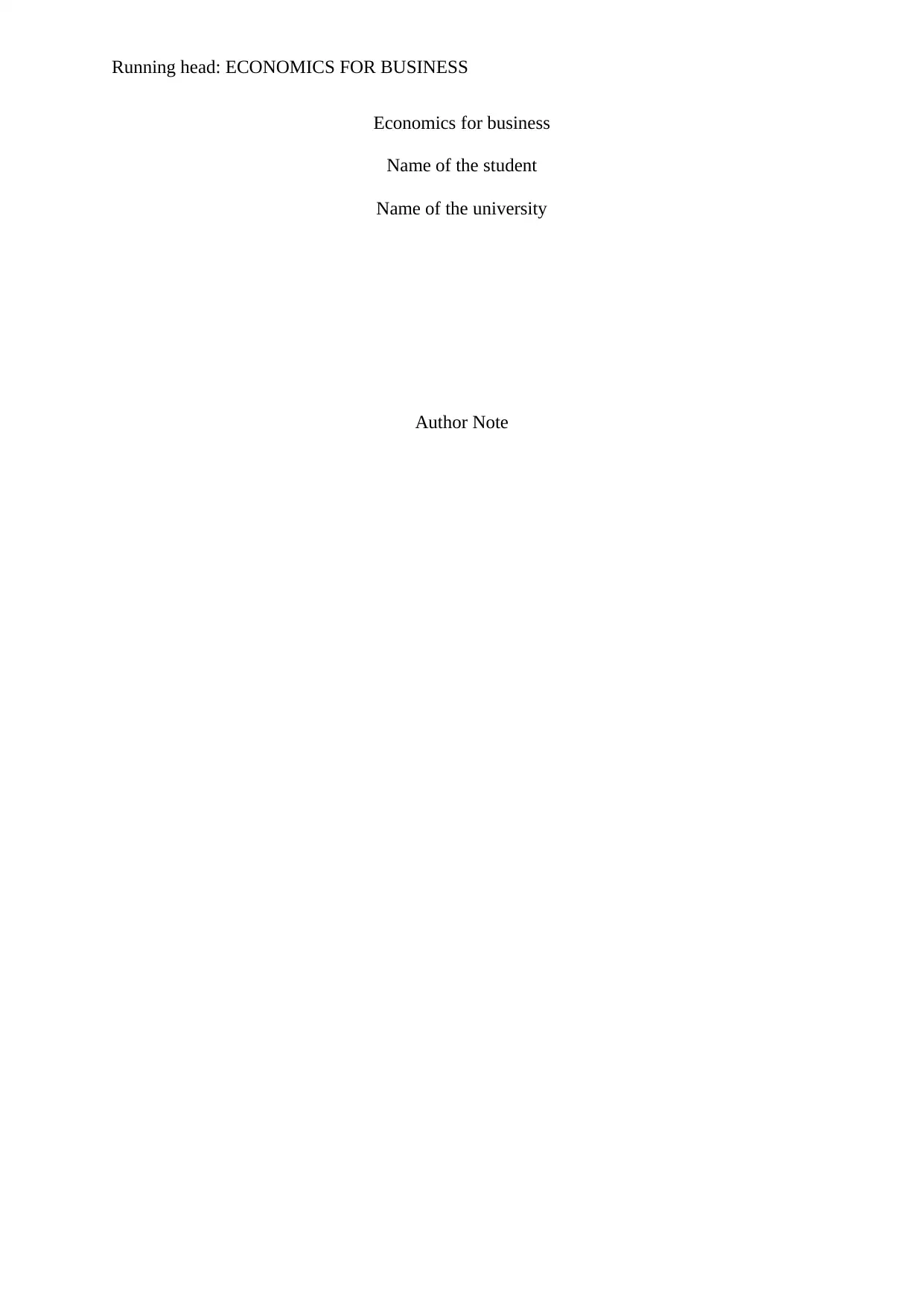
Running head: ECONOMICS FOR BUSINESS
Economics for business
Name of the student
Name of the university
Author Note
Economics for business
Name of the student
Name of the university
Author Note
Paraphrase This Document
Need a fresh take? Get an instant paraphrase of this document with our AI Paraphraser
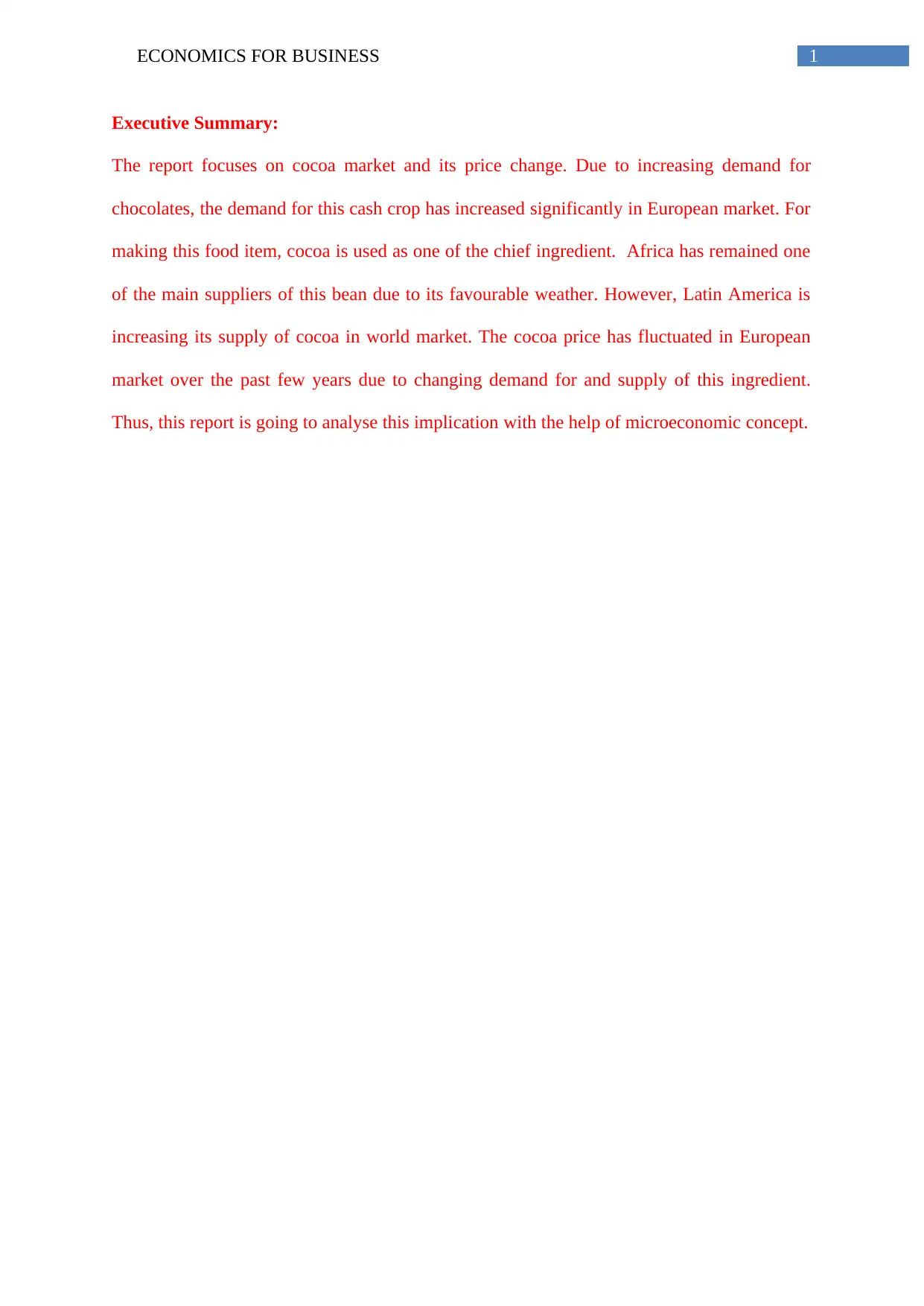
1ECONOMICS FOR BUSINESS
Executive Summary:
The report focuses on cocoa market and its price change. Due to increasing demand for
chocolates, the demand for this cash crop has increased significantly in European market. For
making this food item, cocoa is used as one of the chief ingredient. Africa has remained one
of the main suppliers of this bean due to its favourable weather. However, Latin America is
increasing its supply of cocoa in world market. The cocoa price has fluctuated in European
market over the past few years due to changing demand for and supply of this ingredient.
Thus, this report is going to analyse this implication with the help of microeconomic concept.
Executive Summary:
The report focuses on cocoa market and its price change. Due to increasing demand for
chocolates, the demand for this cash crop has increased significantly in European market. For
making this food item, cocoa is used as one of the chief ingredient. Africa has remained one
of the main suppliers of this bean due to its favourable weather. However, Latin America is
increasing its supply of cocoa in world market. The cocoa price has fluctuated in European
market over the past few years due to changing demand for and supply of this ingredient.
Thus, this report is going to analyse this implication with the help of microeconomic concept.
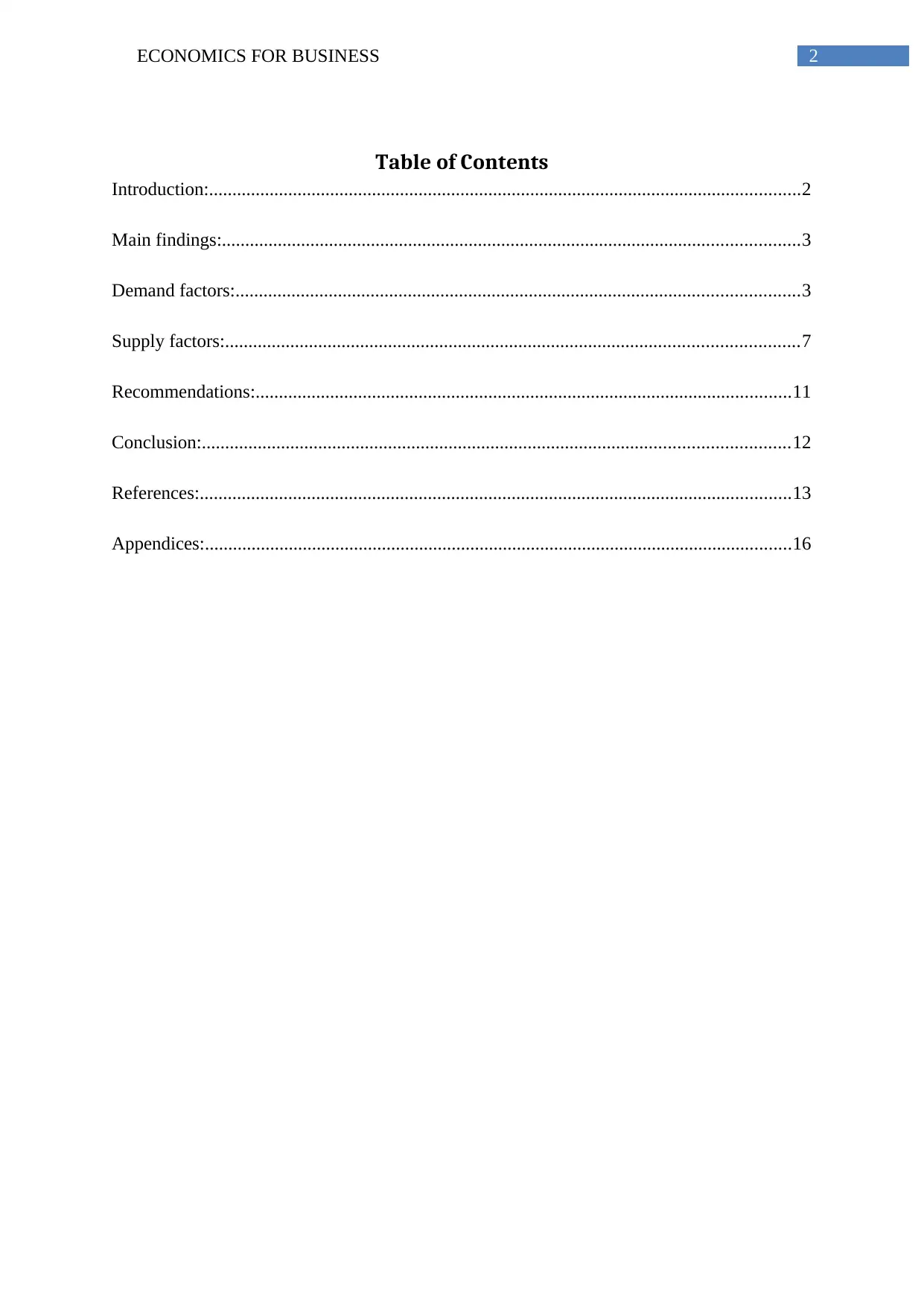
2ECONOMICS FOR BUSINESS
Table of Contents
Introduction:...............................................................................................................................2
Main findings:............................................................................................................................3
Demand factors:.........................................................................................................................3
Supply factors:...........................................................................................................................7
Recommendations:...................................................................................................................11
Conclusion:..............................................................................................................................12
References:...............................................................................................................................13
Appendices:..............................................................................................................................16
Table of Contents
Introduction:...............................................................................................................................2
Main findings:............................................................................................................................3
Demand factors:.........................................................................................................................3
Supply factors:...........................................................................................................................7
Recommendations:...................................................................................................................11
Conclusion:..............................................................................................................................12
References:...............................................................................................................................13
Appendices:..............................................................................................................................16
⊘ This is a preview!⊘
Do you want full access?
Subscribe today to unlock all pages.

Trusted by 1+ million students worldwide
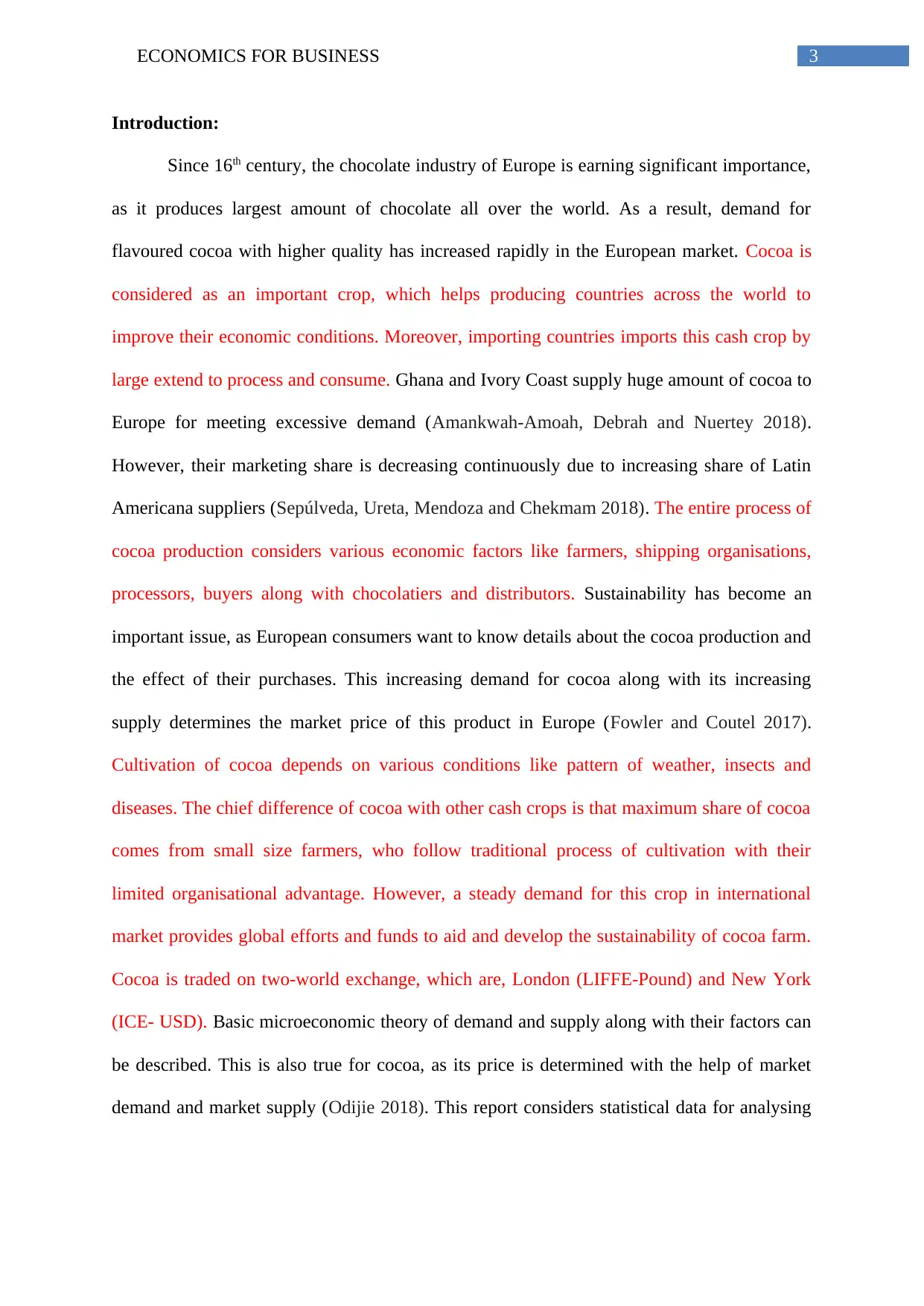
3ECONOMICS FOR BUSINESS
Introduction:
Since 16th century, the chocolate industry of Europe is earning significant importance,
as it produces largest amount of chocolate all over the world. As a result, demand for
flavoured cocoa with higher quality has increased rapidly in the European market. Cocoa is
considered as an important crop, which helps producing countries across the world to
improve their economic conditions. Moreover, importing countries imports this cash crop by
large extend to process and consume. Ghana and Ivory Coast supply huge amount of cocoa to
Europe for meeting excessive demand (Amankwah-Amoah, Debrah and Nuertey 2018).
However, their marketing share is decreasing continuously due to increasing share of Latin
Americana suppliers (Sepúlveda, Ureta, Mendoza and Chekmam 2018). The entire process of
cocoa production considers various economic factors like farmers, shipping organisations,
processors, buyers along with chocolatiers and distributors. Sustainability has become an
important issue, as European consumers want to know details about the cocoa production and
the effect of their purchases. This increasing demand for cocoa along with its increasing
supply determines the market price of this product in Europe (Fowler and Coutel 2017).
Cultivation of cocoa depends on various conditions like pattern of weather, insects and
diseases. The chief difference of cocoa with other cash crops is that maximum share of cocoa
comes from small size farmers, who follow traditional process of cultivation with their
limited organisational advantage. However, a steady demand for this crop in international
market provides global efforts and funds to aid and develop the sustainability of cocoa farm.
Cocoa is traded on two-world exchange, which are, London (LIFFE-Pound) and New York
(ICE- USD). Basic microeconomic theory of demand and supply along with their factors can
be described. This is also true for cocoa, as its price is determined with the help of market
demand and market supply (Odijie 2018). This report considers statistical data for analysing
Introduction:
Since 16th century, the chocolate industry of Europe is earning significant importance,
as it produces largest amount of chocolate all over the world. As a result, demand for
flavoured cocoa with higher quality has increased rapidly in the European market. Cocoa is
considered as an important crop, which helps producing countries across the world to
improve their economic conditions. Moreover, importing countries imports this cash crop by
large extend to process and consume. Ghana and Ivory Coast supply huge amount of cocoa to
Europe for meeting excessive demand (Amankwah-Amoah, Debrah and Nuertey 2018).
However, their marketing share is decreasing continuously due to increasing share of Latin
Americana suppliers (Sepúlveda, Ureta, Mendoza and Chekmam 2018). The entire process of
cocoa production considers various economic factors like farmers, shipping organisations,
processors, buyers along with chocolatiers and distributors. Sustainability has become an
important issue, as European consumers want to know details about the cocoa production and
the effect of their purchases. This increasing demand for cocoa along with its increasing
supply determines the market price of this product in Europe (Fowler and Coutel 2017).
Cultivation of cocoa depends on various conditions like pattern of weather, insects and
diseases. The chief difference of cocoa with other cash crops is that maximum share of cocoa
comes from small size farmers, who follow traditional process of cultivation with their
limited organisational advantage. However, a steady demand for this crop in international
market provides global efforts and funds to aid and develop the sustainability of cocoa farm.
Cocoa is traded on two-world exchange, which are, London (LIFFE-Pound) and New York
(ICE- USD). Basic microeconomic theory of demand and supply along with their factors can
be described. This is also true for cocoa, as its price is determined with the help of market
demand and market supply (Odijie 2018). This report considers statistical data for analysing
Paraphrase This Document
Need a fresh take? Get an instant paraphrase of this document with our AI Paraphraser
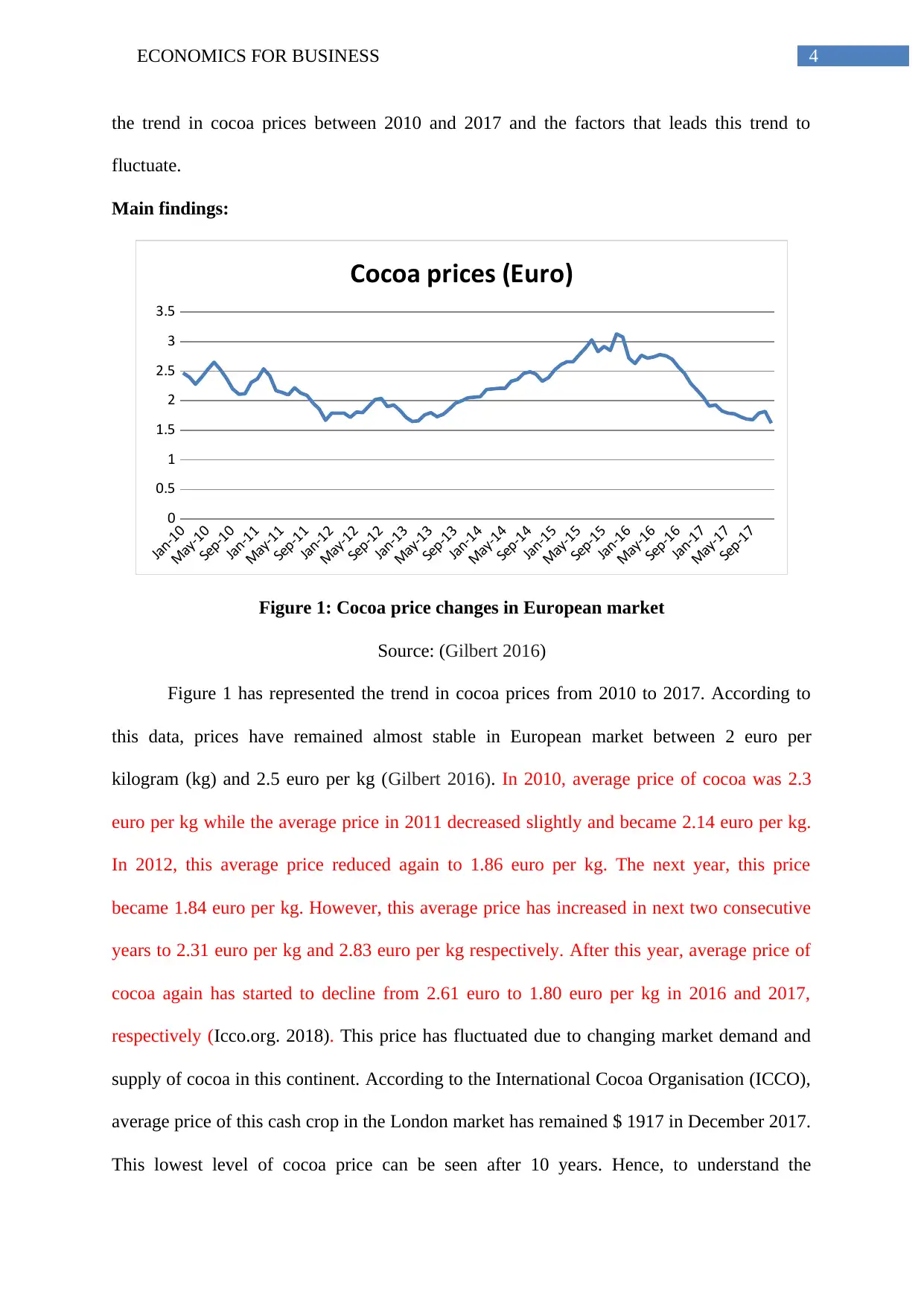
4ECONOMICS FOR BUSINESS
the trend in cocoa prices between 2010 and 2017 and the factors that leads this trend to
fluctuate.
Main findings:
Jan-10
May-10
Sep-10
Jan-11
May-11
Sep-11
Jan-12
May-12
Sep-12
Jan-13
May-13
Sep-13
Jan-14
May-14
Sep-14
Jan-15
May-15
Sep-15
Jan-16
May-16
Sep-16
Jan-17
May-17
Sep-17
0
0.5
1
1.5
2
2.5
3
3.5
Cocoa prices (Euro)
Figure 1: Cocoa price changes in European market
Source: (Gilbert 2016)
Figure 1 has represented the trend in cocoa prices from 2010 to 2017. According to
this data, prices have remained almost stable in European market between 2 euro per
kilogram (kg) and 2.5 euro per kg (Gilbert 2016). In 2010, average price of cocoa was 2.3
euro per kg while the average price in 2011 decreased slightly and became 2.14 euro per kg.
In 2012, this average price reduced again to 1.86 euro per kg. The next year, this price
became 1.84 euro per kg. However, this average price has increased in next two consecutive
years to 2.31 euro per kg and 2.83 euro per kg respectively. After this year, average price of
cocoa again has started to decline from 2.61 euro to 1.80 euro per kg in 2016 and 2017,
respectively (Icco.org. 2018). This price has fluctuated due to changing market demand and
supply of cocoa in this continent. According to the International Cocoa Organisation (ICCO),
average price of this cash crop in the London market has remained $ 1917 in December 2017.
This lowest level of cocoa price can be seen after 10 years. Hence, to understand the
the trend in cocoa prices between 2010 and 2017 and the factors that leads this trend to
fluctuate.
Main findings:
Jan-10
May-10
Sep-10
Jan-11
May-11
Sep-11
Jan-12
May-12
Sep-12
Jan-13
May-13
Sep-13
Jan-14
May-14
Sep-14
Jan-15
May-15
Sep-15
Jan-16
May-16
Sep-16
Jan-17
May-17
Sep-17
0
0.5
1
1.5
2
2.5
3
3.5
Cocoa prices (Euro)
Figure 1: Cocoa price changes in European market
Source: (Gilbert 2016)
Figure 1 has represented the trend in cocoa prices from 2010 to 2017. According to
this data, prices have remained almost stable in European market between 2 euro per
kilogram (kg) and 2.5 euro per kg (Gilbert 2016). In 2010, average price of cocoa was 2.3
euro per kg while the average price in 2011 decreased slightly and became 2.14 euro per kg.
In 2012, this average price reduced again to 1.86 euro per kg. The next year, this price
became 1.84 euro per kg. However, this average price has increased in next two consecutive
years to 2.31 euro per kg and 2.83 euro per kg respectively. After this year, average price of
cocoa again has started to decline from 2.61 euro to 1.80 euro per kg in 2016 and 2017,
respectively (Icco.org. 2018). This price has fluctuated due to changing market demand and
supply of cocoa in this continent. According to the International Cocoa Organisation (ICCO),
average price of this cash crop in the London market has remained $ 1917 in December 2017.
This lowest level of cocoa price can be seen after 10 years. Hence, to understand the
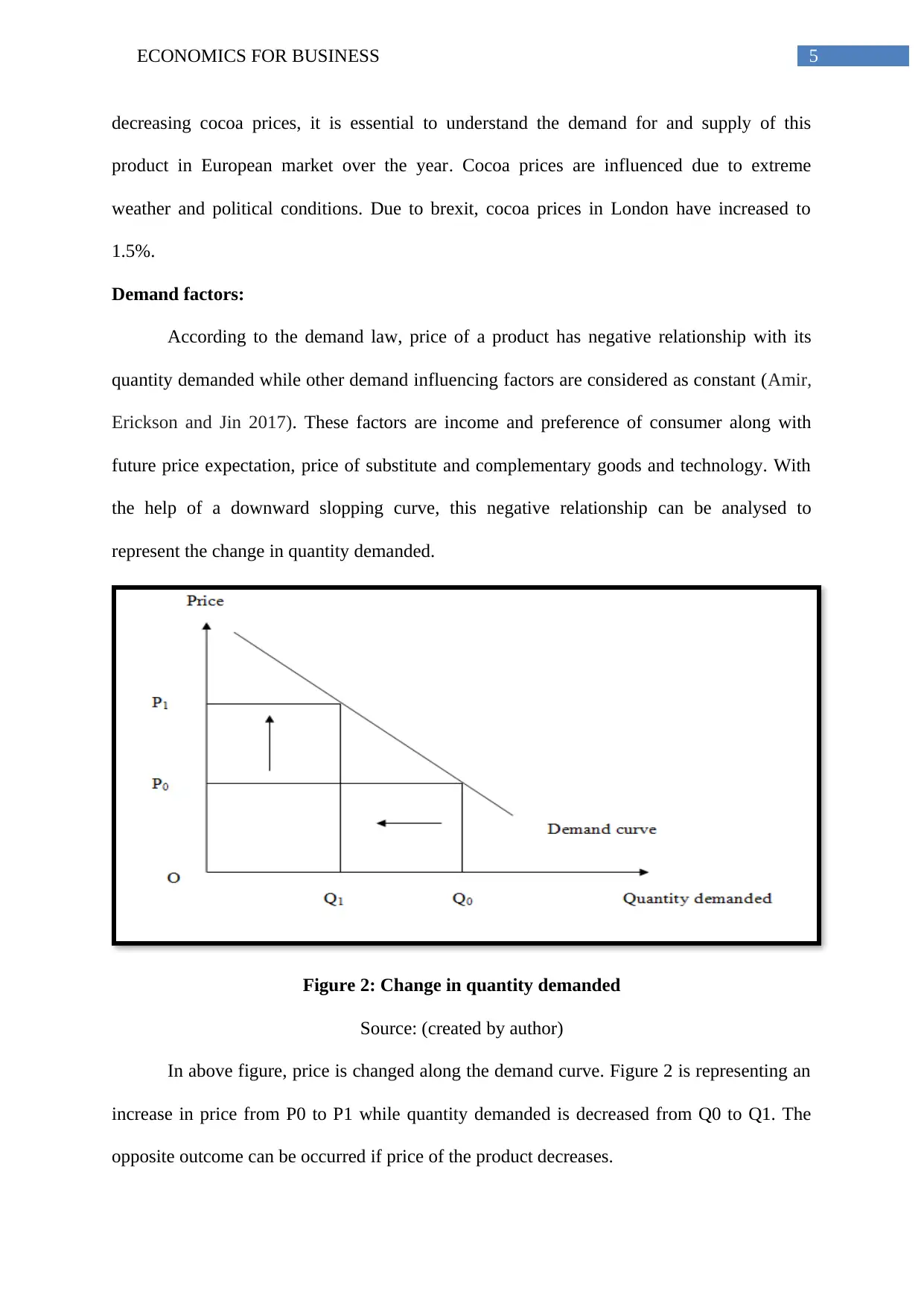
5ECONOMICS FOR BUSINESS
decreasing cocoa prices, it is essential to understand the demand for and supply of this
product in European market over the year. Cocoa prices are influenced due to extreme
weather and political conditions. Due to brexit, cocoa prices in London have increased to
1.5%.
Demand factors:
According to the demand law, price of a product has negative relationship with its
quantity demanded while other demand influencing factors are considered as constant (Amir,
Erickson and Jin 2017). These factors are income and preference of consumer along with
future price expectation, price of substitute and complementary goods and technology. With
the help of a downward slopping curve, this negative relationship can be analysed to
represent the change in quantity demanded.
Figure 2: Change in quantity demanded
Source: (created by author)
In above figure, price is changed along the demand curve. Figure 2 is representing an
increase in price from P0 to P1 while quantity demanded is decreased from Q0 to Q1. The
opposite outcome can be occurred if price of the product decreases.
decreasing cocoa prices, it is essential to understand the demand for and supply of this
product in European market over the year. Cocoa prices are influenced due to extreme
weather and political conditions. Due to brexit, cocoa prices in London have increased to
1.5%.
Demand factors:
According to the demand law, price of a product has negative relationship with its
quantity demanded while other demand influencing factors are considered as constant (Amir,
Erickson and Jin 2017). These factors are income and preference of consumer along with
future price expectation, price of substitute and complementary goods and technology. With
the help of a downward slopping curve, this negative relationship can be analysed to
represent the change in quantity demanded.
Figure 2: Change in quantity demanded
Source: (created by author)
In above figure, price is changed along the demand curve. Figure 2 is representing an
increase in price from P0 to P1 while quantity demanded is decreased from Q0 to Q1. The
opposite outcome can be occurred if price of the product decreases.
⊘ This is a preview!⊘
Do you want full access?
Subscribe today to unlock all pages.

Trusted by 1+ million students worldwide
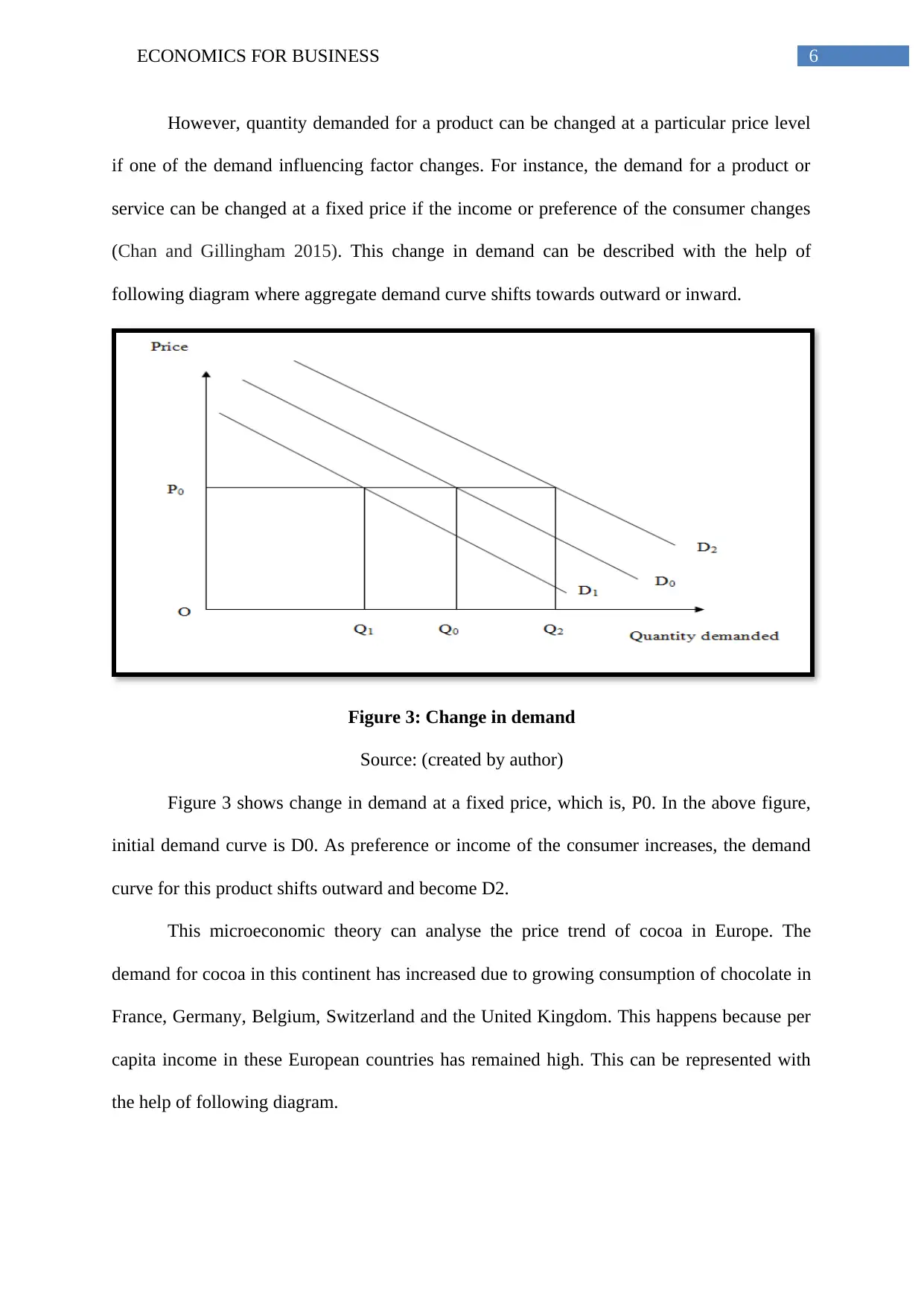
6ECONOMICS FOR BUSINESS
However, quantity demanded for a product can be changed at a particular price level
if one of the demand influencing factor changes. For instance, the demand for a product or
service can be changed at a fixed price if the income or preference of the consumer changes
(Chan and Gillingham 2015). This change in demand can be described with the help of
following diagram where aggregate demand curve shifts towards outward or inward.
Figure 3: Change in demand
Source: (created by author)
Figure 3 shows change in demand at a fixed price, which is, P0. In the above figure,
initial demand curve is D0. As preference or income of the consumer increases, the demand
curve for this product shifts outward and become D2.
This microeconomic theory can analyse the price trend of cocoa in Europe. The
demand for cocoa in this continent has increased due to growing consumption of chocolate in
France, Germany, Belgium, Switzerland and the United Kingdom. This happens because per
capita income in these European countries has remained high. This can be represented with
the help of following diagram.
However, quantity demanded for a product can be changed at a particular price level
if one of the demand influencing factor changes. For instance, the demand for a product or
service can be changed at a fixed price if the income or preference of the consumer changes
(Chan and Gillingham 2015). This change in demand can be described with the help of
following diagram where aggregate demand curve shifts towards outward or inward.
Figure 3: Change in demand
Source: (created by author)
Figure 3 shows change in demand at a fixed price, which is, P0. In the above figure,
initial demand curve is D0. As preference or income of the consumer increases, the demand
curve for this product shifts outward and become D2.
This microeconomic theory can analyse the price trend of cocoa in Europe. The
demand for cocoa in this continent has increased due to growing consumption of chocolate in
France, Germany, Belgium, Switzerland and the United Kingdom. This happens because per
capita income in these European countries has remained high. This can be represented with
the help of following diagram.
Paraphrase This Document
Need a fresh take? Get an instant paraphrase of this document with our AI Paraphraser
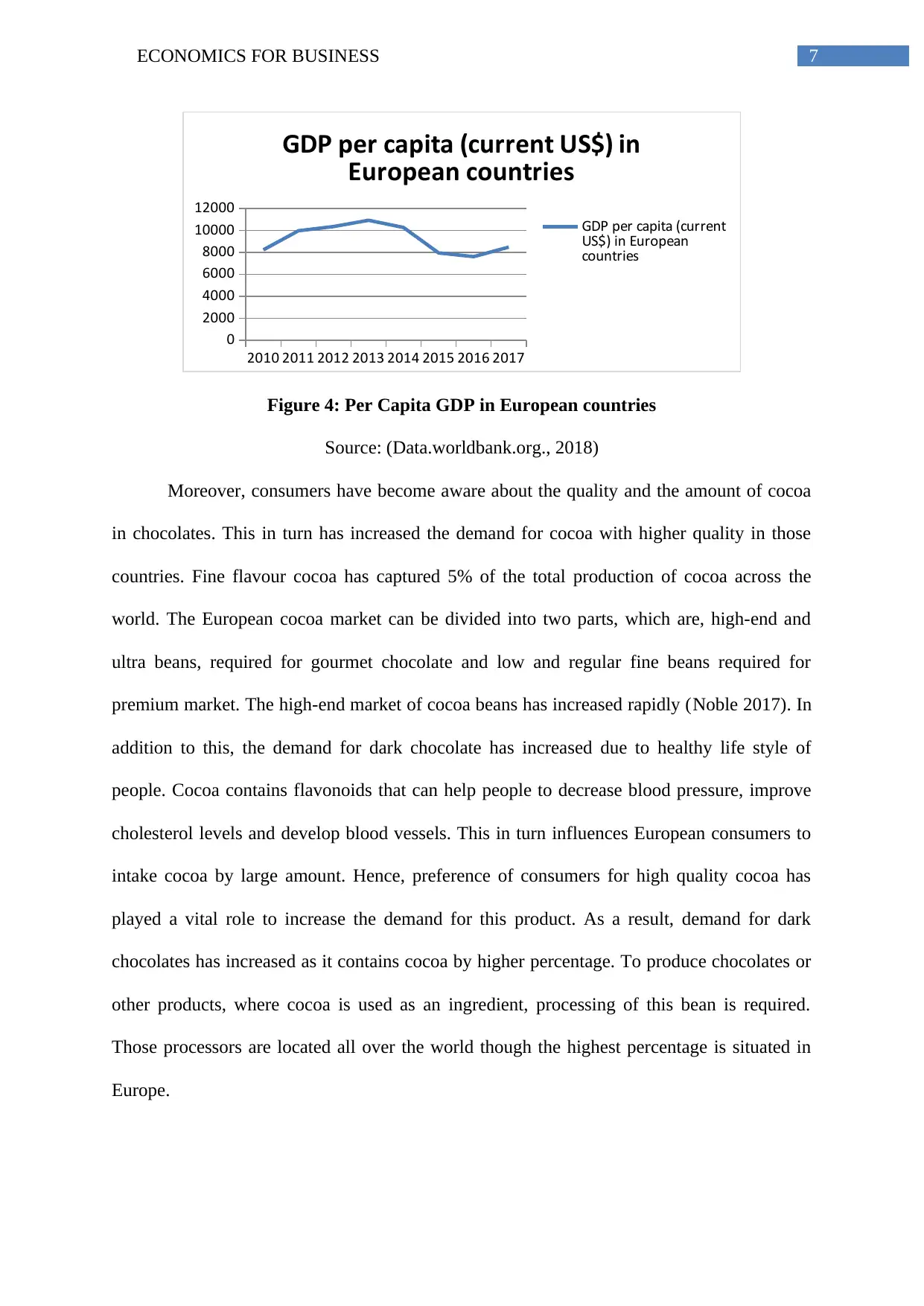
7ECONOMICS FOR BUSINESS
2010 2011 2012 2013 2014 2015 2016 2017
0
2000
4000
6000
8000
10000
12000
GDP per capita (current US$) in
European countries
GDP per capita (current
US$) in European
countries
Figure 4: Per Capita GDP in European countries
Source: (Data.worldbank.org., 2018)
Moreover, consumers have become aware about the quality and the amount of cocoa
in chocolates. This in turn has increased the demand for cocoa with higher quality in those
countries. Fine flavour cocoa has captured 5% of the total production of cocoa across the
world. The European cocoa market can be divided into two parts, which are, high-end and
ultra beans, required for gourmet chocolate and low and regular fine beans required for
premium market. The high-end market of cocoa beans has increased rapidly (Noble 2017). In
addition to this, the demand for dark chocolate has increased due to healthy life style of
people. Cocoa contains flavonoids that can help people to decrease blood pressure, improve
cholesterol levels and develop blood vessels. This in turn influences European consumers to
intake cocoa by large amount. Hence, preference of consumers for high quality cocoa has
played a vital role to increase the demand for this product. As a result, demand for dark
chocolates has increased as it contains cocoa by higher percentage. To produce chocolates or
other products, where cocoa is used as an ingredient, processing of this bean is required.
Those processors are located all over the world though the highest percentage is situated in
Europe.
2010 2011 2012 2013 2014 2015 2016 2017
0
2000
4000
6000
8000
10000
12000
GDP per capita (current US$) in
European countries
GDP per capita (current
US$) in European
countries
Figure 4: Per Capita GDP in European countries
Source: (Data.worldbank.org., 2018)
Moreover, consumers have become aware about the quality and the amount of cocoa
in chocolates. This in turn has increased the demand for cocoa with higher quality in those
countries. Fine flavour cocoa has captured 5% of the total production of cocoa across the
world. The European cocoa market can be divided into two parts, which are, high-end and
ultra beans, required for gourmet chocolate and low and regular fine beans required for
premium market. The high-end market of cocoa beans has increased rapidly (Noble 2017). In
addition to this, the demand for dark chocolate has increased due to healthy life style of
people. Cocoa contains flavonoids that can help people to decrease blood pressure, improve
cholesterol levels and develop blood vessels. This in turn influences European consumers to
intake cocoa by large amount. Hence, preference of consumers for high quality cocoa has
played a vital role to increase the demand for this product. As a result, demand for dark
chocolates has increased as it contains cocoa by higher percentage. To produce chocolates or
other products, where cocoa is used as an ingredient, processing of this bean is required.
Those processors are located all over the world though the highest percentage is situated in
Europe.
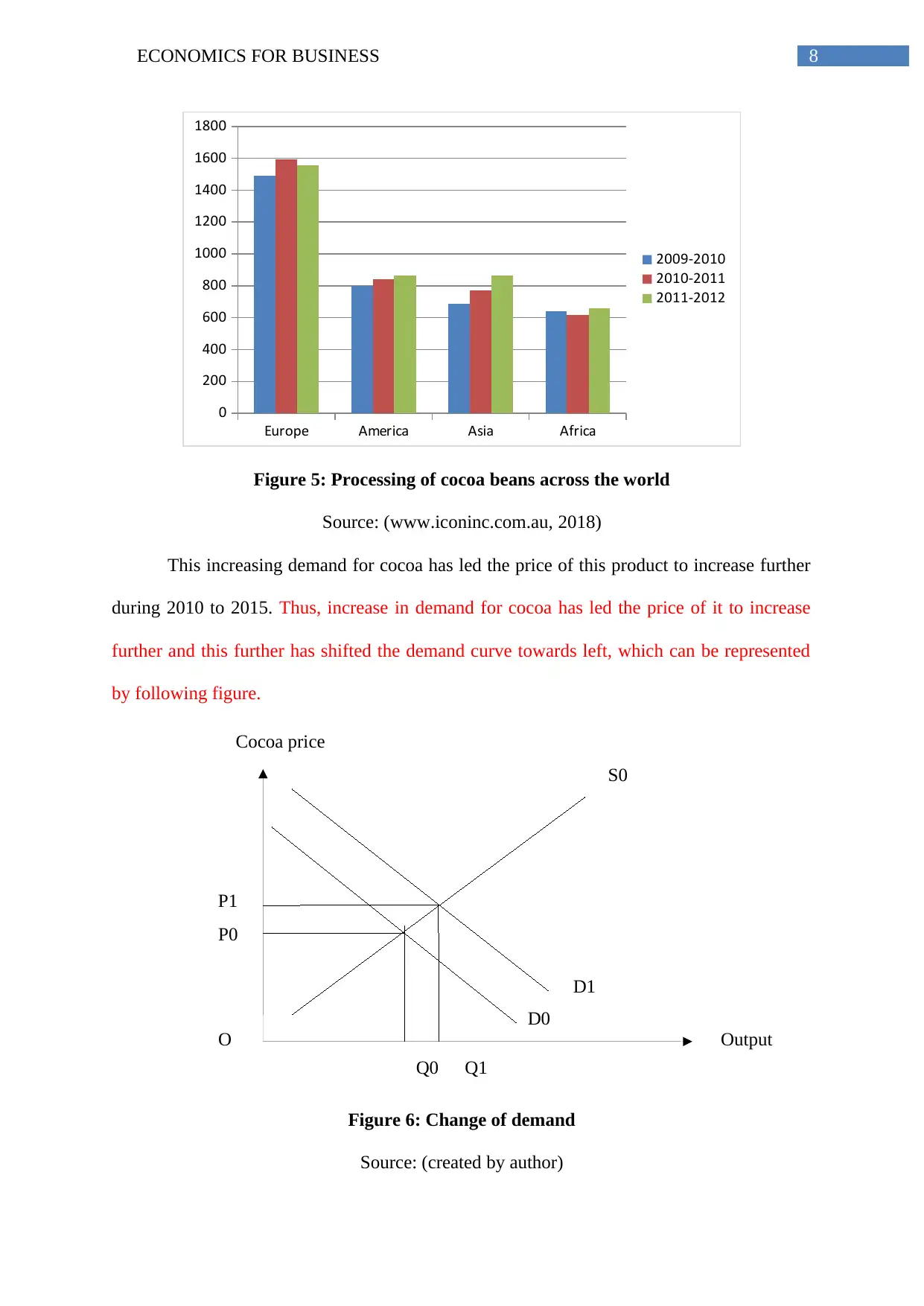
Cocoa price
S0
D0
O
P1
P0
Output
Q1Q0
D1
8ECONOMICS FOR BUSINESS
Europe America Asia Africa
0
200
400
600
800
1000
1200
1400
1600
1800
2009-2010
2010-2011
2011-2012
Figure 5: Processing of cocoa beans across the world
Source: (www.iconinc.com.au, 2018)
This increasing demand for cocoa has led the price of this product to increase further
during 2010 to 2015. Thus, increase in demand for cocoa has led the price of it to increase
further and this further has shifted the demand curve towards left, which can be represented
by following figure.
Figure 6: Change of demand
Source: (created by author)
S0
D0
O
P1
P0
Output
Q1Q0
D1
8ECONOMICS FOR BUSINESS
Europe America Asia Africa
0
200
400
600
800
1000
1200
1400
1600
1800
2009-2010
2010-2011
2011-2012
Figure 5: Processing of cocoa beans across the world
Source: (www.iconinc.com.au, 2018)
This increasing demand for cocoa has led the price of this product to increase further
during 2010 to 2015. Thus, increase in demand for cocoa has led the price of it to increase
further and this further has shifted the demand curve towards left, which can be represented
by following figure.
Figure 6: Change of demand
Source: (created by author)
⊘ This is a preview!⊘
Do you want full access?
Subscribe today to unlock all pages.

Trusted by 1+ million students worldwide
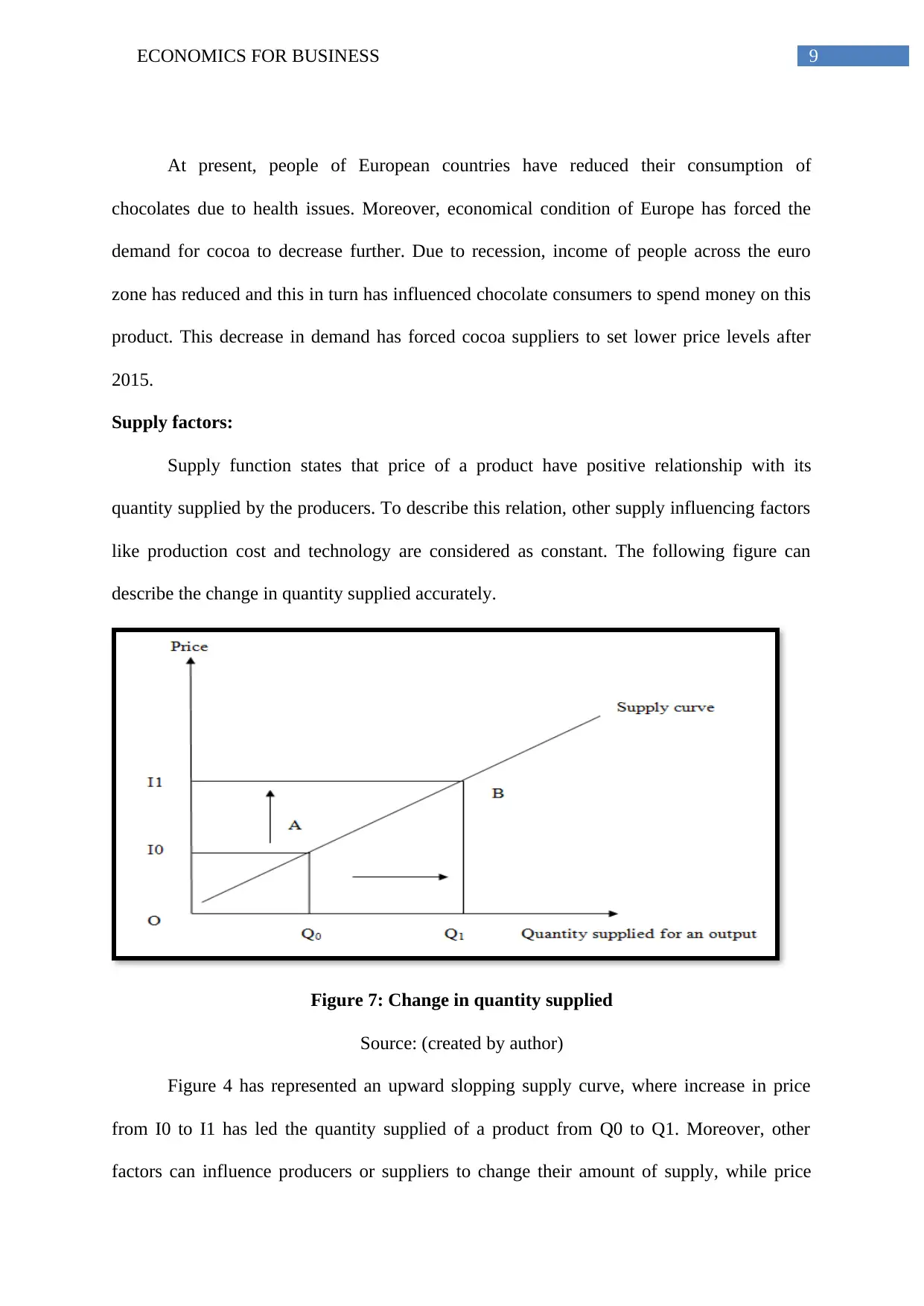
9ECONOMICS FOR BUSINESS
At present, people of European countries have reduced their consumption of
chocolates due to health issues. Moreover, economical condition of Europe has forced the
demand for cocoa to decrease further. Due to recession, income of people across the euro
zone has reduced and this in turn has influenced chocolate consumers to spend money on this
product. This decrease in demand has forced cocoa suppliers to set lower price levels after
2015.
Supply factors:
Supply function states that price of a product have positive relationship with its
quantity supplied by the producers. To describe this relation, other supply influencing factors
like production cost and technology are considered as constant. The following figure can
describe the change in quantity supplied accurately.
Figure 7: Change in quantity supplied
Source: (created by author)
Figure 4 has represented an upward slopping supply curve, where increase in price
from I0 to I1 has led the quantity supplied of a product from Q0 to Q1. Moreover, other
factors can influence producers or suppliers to change their amount of supply, while price
At present, people of European countries have reduced their consumption of
chocolates due to health issues. Moreover, economical condition of Europe has forced the
demand for cocoa to decrease further. Due to recession, income of people across the euro
zone has reduced and this in turn has influenced chocolate consumers to spend money on this
product. This decrease in demand has forced cocoa suppliers to set lower price levels after
2015.
Supply factors:
Supply function states that price of a product have positive relationship with its
quantity supplied by the producers. To describe this relation, other supply influencing factors
like production cost and technology are considered as constant. The following figure can
describe the change in quantity supplied accurately.
Figure 7: Change in quantity supplied
Source: (created by author)
Figure 4 has represented an upward slopping supply curve, where increase in price
from I0 to I1 has led the quantity supplied of a product from Q0 to Q1. Moreover, other
factors can influence producers or suppliers to change their amount of supply, while price
Paraphrase This Document
Need a fresh take? Get an instant paraphrase of this document with our AI Paraphraser
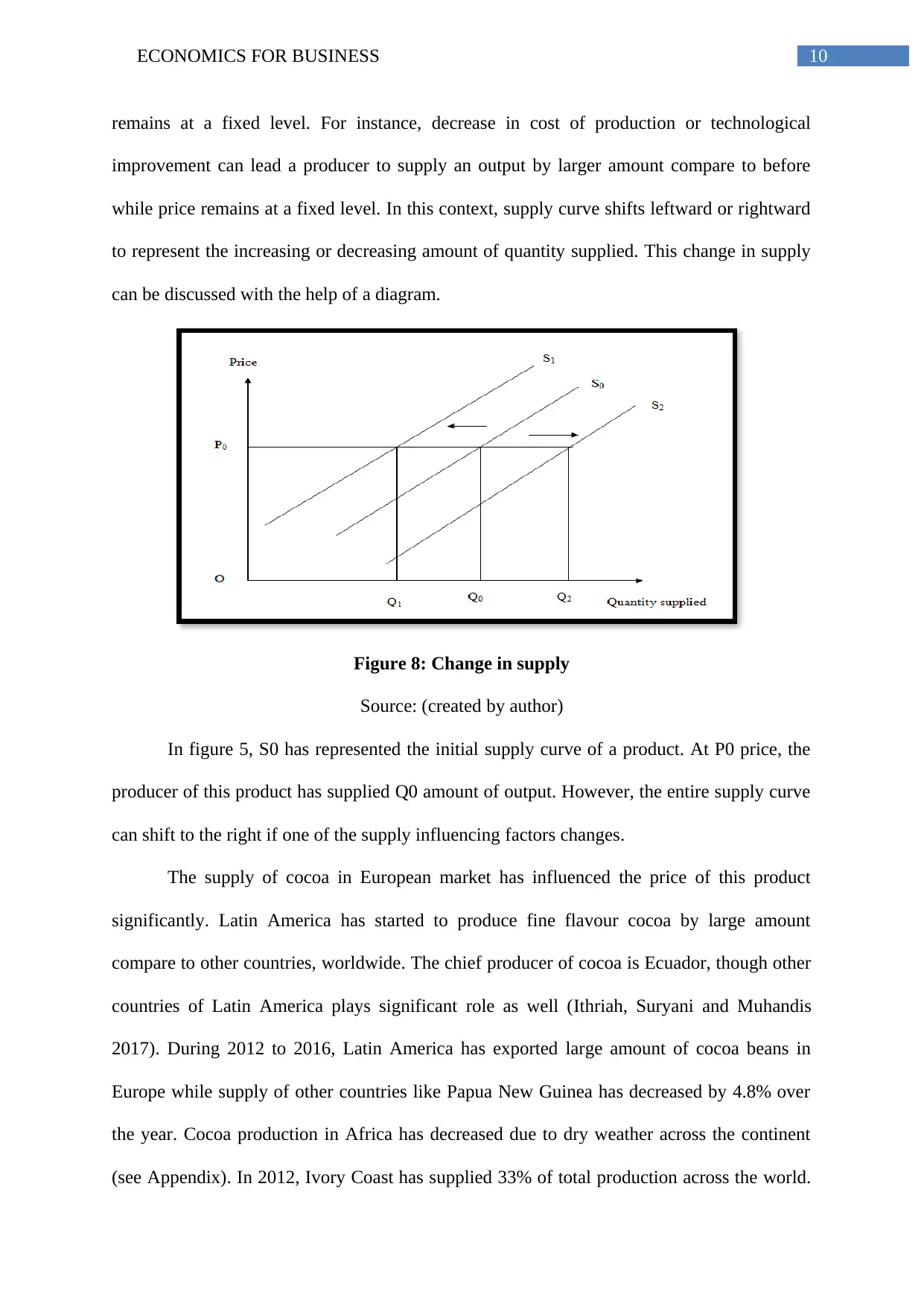
10ECONOMICS FOR BUSINESS
remains at a fixed level. For instance, decrease in cost of production or technological
improvement can lead a producer to supply an output by larger amount compare to before
while price remains at a fixed level. In this context, supply curve shifts leftward or rightward
to represent the increasing or decreasing amount of quantity supplied. This change in supply
can be discussed with the help of a diagram.
Figure 8: Change in supply
Source: (created by author)
In figure 5, S0 has represented the initial supply curve of a product. At P0 price, the
producer of this product has supplied Q0 amount of output. However, the entire supply curve
can shift to the right if one of the supply influencing factors changes.
The supply of cocoa in European market has influenced the price of this product
significantly. Latin America has started to produce fine flavour cocoa by large amount
compare to other countries, worldwide. The chief producer of cocoa is Ecuador, though other
countries of Latin America plays significant role as well (Ithriah, Suryani and Muhandis
2017). During 2012 to 2016, Latin America has exported large amount of cocoa beans in
Europe while supply of other countries like Papua New Guinea has decreased by 4.8% over
the year. Cocoa production in Africa has decreased due to dry weather across the continent
(see Appendix). In 2012, Ivory Coast has supplied 33% of total production across the world.
remains at a fixed level. For instance, decrease in cost of production or technological
improvement can lead a producer to supply an output by larger amount compare to before
while price remains at a fixed level. In this context, supply curve shifts leftward or rightward
to represent the increasing or decreasing amount of quantity supplied. This change in supply
can be discussed with the help of a diagram.
Figure 8: Change in supply
Source: (created by author)
In figure 5, S0 has represented the initial supply curve of a product. At P0 price, the
producer of this product has supplied Q0 amount of output. However, the entire supply curve
can shift to the right if one of the supply influencing factors changes.
The supply of cocoa in European market has influenced the price of this product
significantly. Latin America has started to produce fine flavour cocoa by large amount
compare to other countries, worldwide. The chief producer of cocoa is Ecuador, though other
countries of Latin America plays significant role as well (Ithriah, Suryani and Muhandis
2017). During 2012 to 2016, Latin America has exported large amount of cocoa beans in
Europe while supply of other countries like Papua New Guinea has decreased by 4.8% over
the year. Cocoa production in Africa has decreased due to dry weather across the continent
(see Appendix). In 2012, Ivory Coast has supplied 33% of total production across the world.
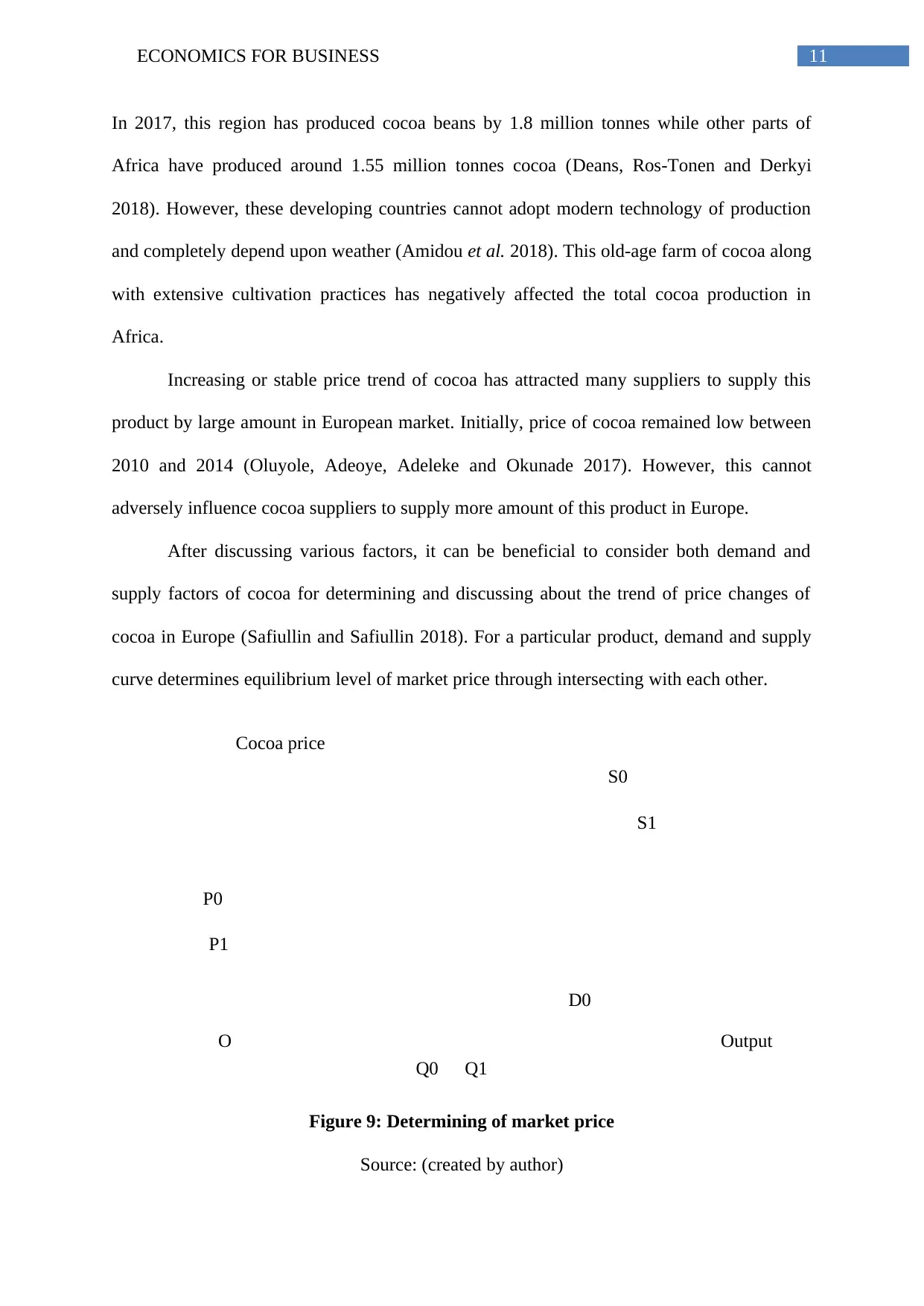
11ECONOMICS FOR BUSINESS
Cocoa price
S0
D0
O
P1
P0
Output
Q1Q0
S1
In 2017, this region has produced cocoa beans by 1.8 million tonnes while other parts of
Africa have produced around 1.55 million tonnes cocoa (Deans, Ros-Tonen and Derkyi
2018). However, these developing countries cannot adopt modern technology of production
and completely depend upon weather (Amidou et al. 2018). This old-age farm of cocoa along
with extensive cultivation practices has negatively affected the total cocoa production in
Africa.
Increasing or stable price trend of cocoa has attracted many suppliers to supply this
product by large amount in European market. Initially, price of cocoa remained low between
2010 and 2014 (Oluyole, Adeoye, Adeleke and Okunade 2017). However, this cannot
adversely influence cocoa suppliers to supply more amount of this product in Europe.
After discussing various factors, it can be beneficial to consider both demand and
supply factors of cocoa for determining and discussing about the trend of price changes of
cocoa in Europe (Safiullin and Safiullin 2018). For a particular product, demand and supply
curve determines equilibrium level of market price through intersecting with each other.
Figure 9: Determining of market price
Source: (created by author)
Cocoa price
S0
D0
O
P1
P0
Output
Q1Q0
S1
In 2017, this region has produced cocoa beans by 1.8 million tonnes while other parts of
Africa have produced around 1.55 million tonnes cocoa (Deans, Ros-Tonen and Derkyi
2018). However, these developing countries cannot adopt modern technology of production
and completely depend upon weather (Amidou et al. 2018). This old-age farm of cocoa along
with extensive cultivation practices has negatively affected the total cocoa production in
Africa.
Increasing or stable price trend of cocoa has attracted many suppliers to supply this
product by large amount in European market. Initially, price of cocoa remained low between
2010 and 2014 (Oluyole, Adeoye, Adeleke and Okunade 2017). However, this cannot
adversely influence cocoa suppliers to supply more amount of this product in Europe.
After discussing various factors, it can be beneficial to consider both demand and
supply factors of cocoa for determining and discussing about the trend of price changes of
cocoa in Europe (Safiullin and Safiullin 2018). For a particular product, demand and supply
curve determines equilibrium level of market price through intersecting with each other.
Figure 9: Determining of market price
Source: (created by author)
⊘ This is a preview!⊘
Do you want full access?
Subscribe today to unlock all pages.

Trusted by 1+ million students worldwide
1 out of 19
Related Documents
Your All-in-One AI-Powered Toolkit for Academic Success.
+13062052269
info@desklib.com
Available 24*7 on WhatsApp / Email
![[object Object]](/_next/static/media/star-bottom.7253800d.svg)
Unlock your academic potential
Copyright © 2020–2025 A2Z Services. All Rights Reserved. Developed and managed by ZUCOL.





